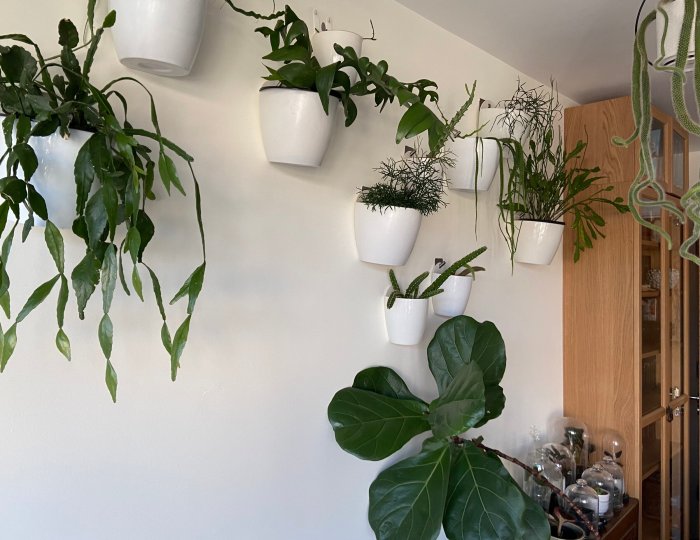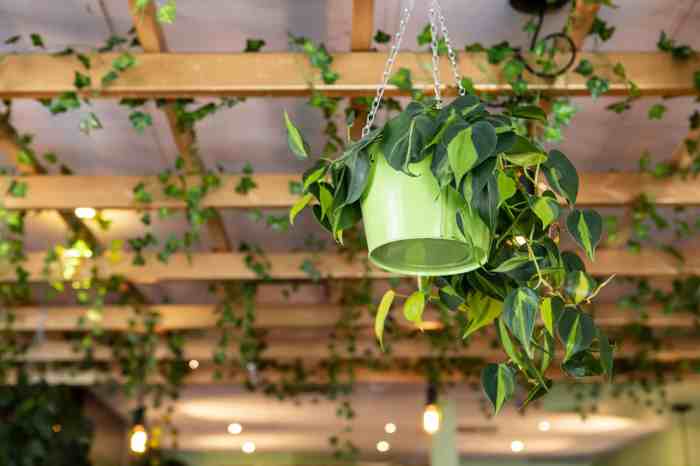Discover innovative ways to bring greenery indoors without damaging your walls with “Hanging Plants Without Drilling Holes.” Explore a range of methods, from adhesive hooks to macrame creations, to elevate your plant displays and create a lush indoor oasis.
This comprehensive guide offers practical solutions and creative inspiration for hanging plants in various spaces, including small apartments, balconies, and outdoor areas. Learn how to choose the right plants and hangers for your specific environment, ensuring their health and vitality.
Hanging Plants Without Damaging Walls

Hanging plants can add life and beauty to any home, but traditional methods often involve drilling holes into walls, which can damage the surface and leave unsightly marks. Fortunately, there are several innovative ways to hang plants without causing any damage.
One popular method is to use adhesive hooks. These hooks are designed to stick to walls without leaving any residue, making them ideal for hanging lightweight plants. They are easy to install and can be removed without damaging the wall.
Another option is to use adhesive strips. These strips are similar to adhesive hooks, but they are wider and can support more weight. They are also easy to install and remove, but they may leave a slight residue on the wall.
Tension rods are another great way to hang plants without damaging walls. These rods are designed to fit between two walls or surfaces, creating a tension that holds them in place. They can be used to hang plants from ceilings or walls, and they are adjustable to fit different heights.
Each of these methods has its own benefits and limitations. Adhesive hooks are the most versatile and easy to use, but they may not be strong enough to support heavy plants. Adhesive strips are stronger than adhesive hooks, but they may leave a residue on the wall.
Tension rods are the strongest and most adjustable, but they may not be suitable for all spaces.
Creative Plant Hanger Ideas

Hanging plants can add a touch of greenery and life to any room without taking up valuable floor space. But if you don’t want to drill holes in your walls, there are plenty of other creative ways to hang plants.
Macrame, yarn, and repurposed materials can all be used to create unique and stylish plant hangers that will complement any decor. Here are a few ideas to get you started:
Macrame Plant Hangers
Macrame is a type of knotting that can be used to create beautiful and intricate plant hangers. There are many different macrame patterns available, so you can find one that fits your style and skill level. Once you’ve mastered the basics, you can even create your own designs.
Yarn Plant Hangers
Yarn is another great material for making plant hangers. It’s inexpensive and easy to work with, and it comes in a wide variety of colors and textures. You can use yarn to create simple braided or wrapped hangers, or you can get more creative with your designs.
Repurposed Material Plant Hangers
There are endless possibilities when it comes to repurposing materials into plant hangers. You can use old belts, scarves, jewelry, or even pieces of wood to create unique and stylish hangers that will add character to your home.
Plant Hangers for Specific Spaces

Hanging plants add a touch of greenery and life to any space, but not all hangers are created equal. When choosing plant hangers for specific spaces, it’s important to consider the size of the space, the amount of natural light, and the type of plants you want to hang.
For small apartments, vertical gardens are a great way to maximize space. These gardens can be hung on walls or doors, and they allow you to grow multiple plants in a small area. Wall-mounted planters are another option for small spaces.
These planters can be hung on walls or ceilings, and they come in a variety of shapes and sizes to accommodate different types of plants.
For balconies, hanging baskets are a popular choice. These baskets can be hung from the ceiling or from the railing, and they provide a great way to add some greenery to your outdoor space. When choosing hanging baskets for balconies, be sure to choose a size that is appropriate for the space and the type of plants you want to grow.
For outdoor areas, there are a variety of hanging plant options to choose from. Macrame hangers are a popular choice for outdoor spaces, as they are durable and can withstand the elements. Metal hangers are another option for outdoor spaces, as they are strong and can hold heavy plants.
For those seeking to enhance their living spaces with greenery without damaging walls, hanging plants without drilling holes is a viable solution. Wall plant hanger bunnings offers a range of options to effortlessly suspend plants, complementing various interior styles. These hangers provide a convenient and aesthetic way to display plants, creating a vibrant and welcoming atmosphere without the need for permanent fixtures.
When choosing hanging plant options for outdoor areas, be sure to choose a style that complements the décor of your space.
Factors to Consider When Choosing Plants and Hangers for Specific Environments
- Size of the space:The size of the space will determine the size of the plant hangers you can use. For small spaces, vertical gardens or wall-mounted planters are a good option. For larger spaces, hanging baskets or macrame hangers are a good choice.
Hanging plants can add a touch of greenery to any room without the need for drilling holes. Whether you’re looking to add some life to a corner or create a vertical garden, there are many options for where to place hanging plants.
For inspiration, check out our guide on where to place hanging plants . Once you’ve chosen the perfect spot, you can enjoy the benefits of hanging plants without the hassle of drilling holes.
- Amount of natural light:The amount of natural light in the space will determine the type of plants you can grow. If the space has a lot of natural light, you can grow a variety of plants. If the space has limited natural light, you will need to choose plants that are tolerant of low light conditions.
- Type of plants:The type of plants you want to grow will determine the type of plant hangers you need. For example, if you want to grow heavy plants, you will need to choose strong hangers that can support the weight of the plants.
Plant Care for Hanging Plants: Hanging Plants Without Drilling Holes
Maintaining healthy hanging plants requires proper care, including watering, fertilizing, and ensuring adequate drainage and sunlight exposure. Understanding the specific needs of different plant types and adjusting care accordingly is essential for thriving indoor greenery.
Watering
The frequency of watering for hanging plants depends on the type of plant, its size, the material of the hanging container, and environmental conditions. Generally, plants in porous containers, such as terracotta, require more frequent watering than those in plastic or glazed containers.
Check the soil moisture regularly by inserting your finger about an inch deep into the soil. Water thoroughly when the soil feels dry to the touch.
Fertilizing
Fertilize hanging plants regularly during the growing season, typically from spring to fall. Use a balanced liquid fertilizer diluted to half strength. Avoid over-fertilizing, as it can damage the plant’s roots. Follow the instructions on the fertilizer label carefully.
Drainage and Sunlight
Proper drainage is crucial for hanging plants to prevent root rot. Choose containers with drainage holes and ensure they are not sitting in water. Adequate sunlight exposure is also essential for plant growth. Determine the light requirements of your specific plant and provide the appropriate amount of indirect or direct sunlight.
Troubleshooting Hanging Plant Problems
Hanging plants bring a touch of greenery to any space, but they can also come with their own set of challenges. Common issues include yellowing leaves, root rot, and pests. Here’s how to identify and solve these problems to keep your hanging plants thriving.
Yellowing Leaves, Hanging plants without drilling holes
Yellowing leaves can indicate a number of issues, including nutrient deficiencies, overwatering, or underwatering. To determine the cause, check the soil moisture and fertilize the plant if necessary. If the soil is too wet, reduce watering frequency. If the soil is too dry, increase watering frequency.
Hanging plants without drilling holes is a great way to add some greenery to your home without damaging your walls. There are a number of different ways to do this, but one of the most popular is to use hanging pots.
Hanging pots bunnings come in a variety of shapes and sizes, so you can find one that will fit your needs and décor. They are also relatively inexpensive, so you can add some greenery to your home without breaking the bank.
Hanging plants without drilling holes is a great way to add some life to your home, and it’s a project that can be completed in just a few minutes.
Root Rot
Root rot occurs when the roots of the plant become waterlogged and start to decay. This can be caused by overwatering or poor drainage. To prevent root rot, make sure the pot has drainage holes and water the plant only when the soil is dry to the touch.
Pests
Hanging plants can be susceptible to a variety of pests, including aphids, mealybugs, and spider mites. These pests can damage the leaves and stems of the plant, causing them to wilt or yellow. To control pests, use an insecticidal soap or neem oil spray.
You can also try using a natural pest repellent, such as cinnamon or peppermint oil.
Final Summary

Hanging plants without drilling holes empowers you to transform your living space into a verdant sanctuary without compromising the integrity of your walls. Whether you’re a seasoned plant enthusiast or just starting your indoor garden, this guide provides everything you need to create a stunning and thriving plant display.
Key Questions Answered
How can I hang heavy plants without drilling?
Use tension rods or heavy-duty adhesive hooks designed for heavier items.
What is the best way to hang plants from a ceiling?
Install a ceiling hook or use a macrame hanger that can be attached to a ceiling beam.
How do I water hanging plants?
Use a watering can with a long spout or a spray bottle to reach the soil.